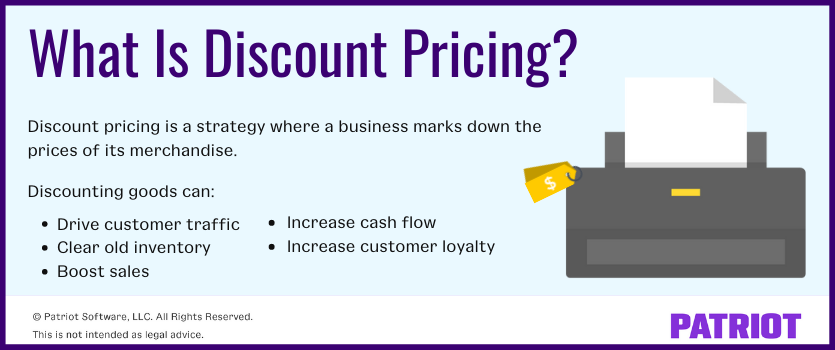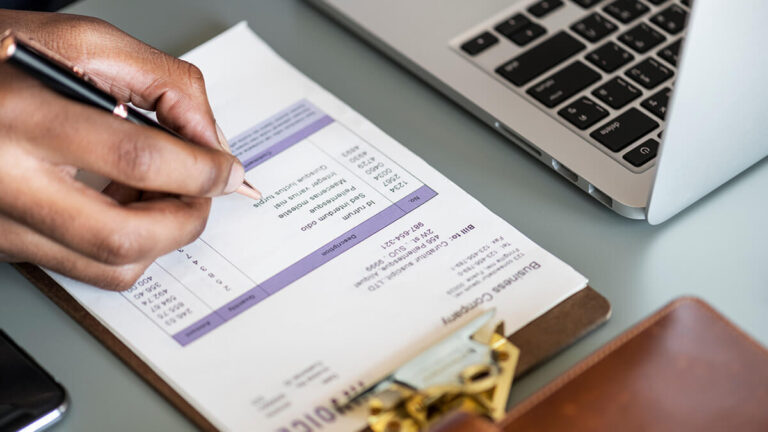After weeks of back and forth, you finally break down and are ready to buy that new plasma screen TV. But before you take the plunge, do you look for discount pricing to score the best deal? If you do, you’re like 74% of Americans who say special offers are a top factor when deciding where and what to buy online.
Pricing discounts are what the majority of consumers want. And as a business owner, you can be the one to offer them.
Read on to learn the ins and outs of the discount strategy game, including:
- What is discount pricing?
- Types of discount strategies
- How to account for discounts
- How to discount a price
What is discount pricing?
Discount pricing is a type of pricing strategy where a business marks down the prices of its merchandise. The goal of a price reduction strategy is to increase customer traffic, clear old inventory, and increase sales. Most businesses use a discount pricing strategy temporarily (e.g., seasonal discounts) rather than offering nonstop discounts. That way, you don’t wind up depending on discount pricing for long periods of time.

Before sending out coupons or announcing a storewide discount, you should consider key factors such as your:
- Profit margin
- Current pricing strategy
- Consumer demand
- Ability to get wholesale pricing
If you continually mark down costs, you could wind up losing money. And, customers might not feel a sense of value or urgency if everything is always marked down.
Pro tip: Large companies often have lower prices because they can get bulk pricing, making it difficult for small businesses to compete. Emphasize the uniqueness of your products or services, and occasionally offer discounts to maximize effectiveness.
Benefits of a discount strategy
Discounts are a win-win for customers and business owners alike. But what exactly are the benefits of using a discount strategy?
By discounting products or services, you can:
- Increase cash flow
- Get rid of old inventory
- Boost customer loyalty
If you aren’t on track to meet your sales targets, offering discounts could help get you enough incoming money to cover your expenses.
Offering discounts can also eliminate surplus inventory and make way for new inventory. Not to mention, having too much inventory can lead to high storage costs or shrinkage.
Customers who receive discounts might have more loyalty toward your store. Discounts help customers feel like they’re getting better deals. And, customers who receive loyalty discounts might feel more valued.
Types of discount pricing strategies
Want to use a discount pricing strategy? There are a few types of discounts you can choose between:
- Promotional discounts: Discounts you offer on all or some products for a limited time.
- Early payment discounts: Discounts you offer customers for paying their invoices before the due date.
- Seasonal discounts: Discounts you can offer at the end of a season (e.g., winter sale).
- Loyalty discounts: Discounts customers can receive if they spend a certain amount or make a set number of purchases.
- Referral discounts: Discounts you offer customers for referring someone to your business.
- Volume discounts: Discounts customers receive when they buy in bulk.
Some discounts are only available temporarily (e.g., promotional) while others are ongoing (e.g., referral). And, several types of discounts require customers to take some sort of action (e.g., loyalty) while others require no action (e.g., promotional).
Want a closer look? Read on to learn more about the types of discount strategies and see discount pricing examples.
1. Promotional discounts
Want to increase customer traffic and sales? Interested in getting rid of outdated inventory to make room for new stuff? If so, you may consider offering promotional discounts. These are discounts you offer for a limited time. Typically, businesses offer this type of discount toward the end of a product’s life cycle.
You may choose to offer promotions during holidays or other big events, like a new product release.
Promotions you can offer include:
- Buy one, get one (BOGO) free or half off on certain items
- Storewide BOGO
- Percentage off certain items
- Storewide percentage off (Everything 50% off!)
2. Early payment discounts
Encourage customers to pay their bills before the due dates through an early payment discount. For example, you may give customers a 10% discount for paying their invoice within 10 days instead of the 30-day deadline.
Early payment discounts can be temporary or ongoing. You may offer an early payment discount once on a big purchase or offer them on each invoice you send (the choice is yours!).
Generally, you include the payment terms on the customer’s invoice. Write it as the percentage discount the customer will receive, followed by the number of days the offer is good until, followed by the normal due date. For example, 2/10, Net 30 means you offer a 2% discount if customers pay their invoice within 10 days instead of a normal 30-day due date.
3. Seasonal discounts
You can offer seasonal discounts to all customers. Use seasonal discounts to get rid of old inventory. Mark down items that are out of season.
For example, you own a clothing store. When it’s almost springtime, you mark down winter coats. This encourages customers to buy the coats (so you can make way for spring clothing) and reduces the burden of inventory seasonality on your bottom line.
4. Loyalty discounts
Offering a loyalty program at your small business shows frequent customers you value them. And, it encourages customers to buy from you more often. You can give members of your loyalty program discounts.
After a customer spends a certain amount or makes a set number of purchases, they receive a discount. You may decide to give discounts on any product or service in your store, or you can discount certain products.
Some businesses send members discounts based on their buying habits. Using this tactic can help you upsell products as well. Loyalty member discounts can lead customers to purchase more expensive, related items.
For example, you own a store that sells home items. You notice one of your loyalty members always purchases outdoor supplies. After buying a lawnmower, you give them a loyalty member discount for a hedge trimmer.
5. Referral discounts
Want customers to spread the word about your business? Great! To do that, you may consider offering a referral discount. Through a referral discount, customers receive the discount when they take action (e.g., get new customers for you).
A referral discount generally gets both your referring customer and the new customer a deal. For example, you can give your customers a 25% discount for referring new customers, who also receive a 25% discount on their first purchase.
6. Volume discounts
With a volume discount pricing strategy, you offer customers a discount when they buy in bulk. This gives customers a discount when they purchase more merchandise.
If you’re a business-to-business company, a volume discount is especially useful. Many businesses need to buy goods in large quantities.
Let’s say you sell office supplies. You could offer a discounted price for customers who buy 20 or more boxes of 500-count paper.
Offering discounts for wholesale buying helps you get rid of some inventory, sell more items, and keep customers happy.
How to account for discounts
So, you made the discounted sale. Now, you need to account for it. To do that, your journal entry should reflect the discount you gave the customer. And, record your total sales discounts for an accounting period on your business income statement.
You can account for discounts using the following accounts:
- Accounts Receivable
- Sales Revenue
- Cash
- Sales Discounts
When you first make the sale, debit your Accounts Receivable account and credit your Sales Revenue account:
| Date | Account | Debit | Credit |
|---|---|---|---|
| XX/XX/XXXX | Accounts Receivable | X | |
| Sales Revenue | X |
After the customer pays, debit your Cash and Sales Discounts accounts. Credit your Accounts Receivable account to decrease the account and show the customer paid:
| Date | Account | Debit | Credit |
|---|---|---|---|
| XX/XX/XXXX | Cash | X | |
| Sales Discounts | X | ||
| Accounts Receivable | X |
Let’s see it in action. Say a customer spends $1,000 and receives a $100 discount. Your journal entries would look like this:
| Date | Account | Debit | Credit |
|---|---|---|---|
| XX/XX/XXXX | Accounts Receivable | 1,000 | |
| Sales Revenue | 1,000 |
| Date | Account | Debit | Credit |
|---|---|---|---|
| XX/XX/XXXX | Cash | 900 | |
| Sales Discounts | 100 | ||
| Accounts Receivable | 1,000 |
Sales discounts allowance account
You can also use a sales discounts allowance account. You may decide to go this route if you plan on doing a storewide discount or offering frequent discounts—and invoicing for payment later.
By using a sales discounts allowance account, you can immediately account for the discount when a customer makes a sale and plans to pay later. That way, you don’t need to worry about invoicing customers in one period and recording the discount in another period.
Here’s how it works: You set aside an allowance. When you make a sale, debit your Accounts Receivable account and credit your Sales Revenue account like normal.
| Date | Account | Debit | Credit |
|---|---|---|---|
| XX/XX/XXXX | Accounts Receivable | X | |
| Sales Revenue | X |
And, immediately debit the Sales Discounts account for the amount of the discount and credit your Allowance for Sales Discounts account for the same amount.
| Date | Account | Debit | Credit |
|---|---|---|---|
| XX/XX/XXXX | Sales Discounts | X | |
| Allowance for Sales Discounts | X |
When the customer pays their invoice, debit your Cash account and Allowance for Sales Discounts. Then, credit your Accounts Receivable account (since the customer paid).
| Date | Account | Debit | Credit |
|---|---|---|---|
| XX/XX/XXXX | Cash | X | |
| Allowance for Sales Discounts | X | ||
| Accounts Receivable | X |
Let’s see it in action. Again, say a customer spends $1,000 and receives a $100 discount. Your journal entries would look like this:
| Date | Account | Debit | Credit |
|---|---|---|---|
| XX/XX/XXXX | Accounts Receivable | 1,000 | |
| Sales Revenue | 1,000 |
| Date | Account | Debit | Credit |
|---|---|---|---|
| XX/XX/XXXX | Sales Discounts | 100 | |
| Allowance for Sales Discounts | 100 |
| Date | Account | Debit | Credit |
|---|---|---|---|
| XX/XX/XXXX | Cash | 900 | |
| Allowance for Sales Discounts | 100 | ||
| Accounts Receivable | 1,000 |
How to discount a price
Ready to reap the benefits of offering customers a discount? Get started with the following four steps:
- Choose your strategy: BOGO discount? Early payment discount? First, decide the type of discount strategy you want to offer. Then, figure out the logistics, such as amounts, start and end dates, and how often you plan on offering the discount.
- Market it: You want customers to know about the discounts you offer. Promote upcoming (e.g., seasonal) or ongoing (e.g., referral) discounts in your marketing materials.
- Apply discount at the point of sale: If you forget to apply the discount, your customers will probably let you know about it. Regardless, be ready to apply discounts at the point of sale for a smoother transaction.
- Account for discounts in your books: The last thing you want is mismatched records and confusion at the end of the accounting period. Record discount amounts in your books for accurate recordkeeping.
Need a way to keep track of incoming money? Patriot’s online accounting software lets you record income and payments easily. Try it for free today!
This article has been updated from its original publication date of October 10, 2017.
This is not intended as legal advice; for more information, please click here.






